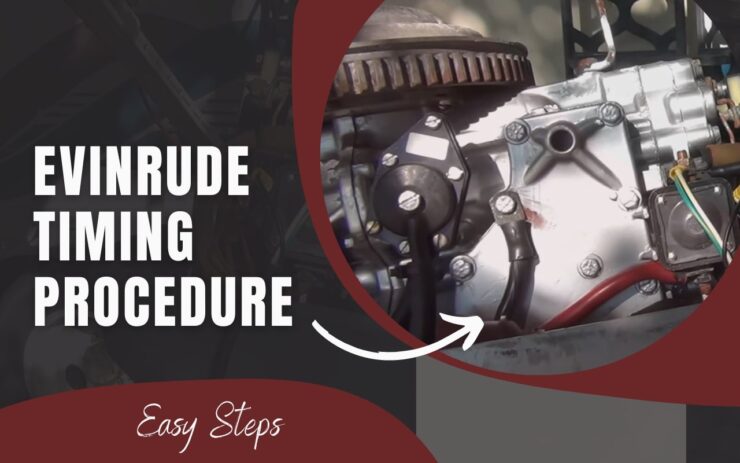The timing procedure refers to the process of setting the ignition timing of an internal combustion engine. The timing determines the precise moment when the spark plug fires, igniting the fuel and air mixture in the combustion chamber. The timing is critical to the performance of the engine, as it affects factors such as power output, fuel efficiency, and emissions.
The timing procedure involves adjusting the position of the distributor in relation to the engine’s crankshaft. This adjustment is necessary to ensure the spark plug fires at the correct moment in the engine’s cycle. The timing is usually set to a specific degree before or after top dead center (BTDC or ATDC), which is the point where the piston is at its highest point in the cylinder.
To set the timing, a timing light is used to illuminate a timing mark on the engine’s crankshaft pulley or flywheel. The distributor is then adjusted until the timing mark lines up with a reference point on the engine. Once the timing is set, the distributor is secured in place to prevent it from moving.
The timing procedure is a critical aspect of maintaining the performance and longevity of an internal combustion engine. An incorrectly timed engine can cause poor performance, rough idling, and potential engine damage. Regular maintenance and adjustment of the timing can help prevent these issues from occurring and ensure the engine runs smoothly and efficiently.
Proper timing is essential for the smooth and reliable operation of an Evinrude outboard motor.
It’s no secret that Evinrude outboard motors are some of the best known and most respected on the market. A motor’s timing may need to be altered from time to time.
In addition, it’s needed to replace the water pump and impeller. Using an engine’s link rods, the timing can be fine-tuned. Setting the Evinrude’s timing should only take about an hour.
So, what are the steps of the Evinrude timing procedure you need to follow?
When a timer base or stator is out of sync it may make ticking noises or start inconsistently. For troubleshooting, set the spark advance. Then set the crankshaft. Find the spring and move the throttle. Mark the flywheel as you set the timer. Warm up the engine. Make sure the boat is tethered.
To find out more, read the entire article.
Table of Contents
ToggleTroubleshooting of Evinrude Timing Procedure
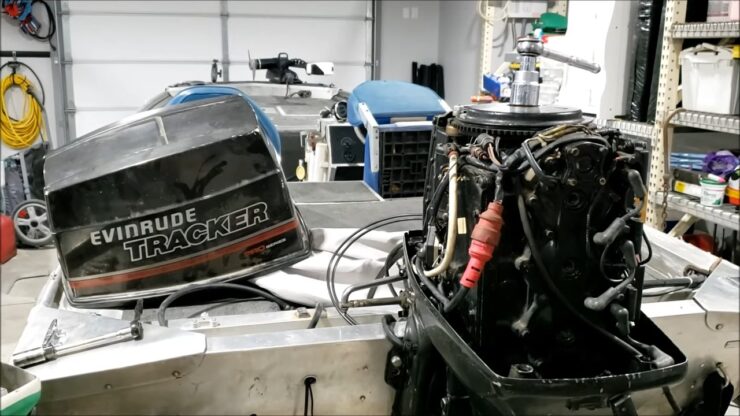
When a timer base or stator is out of sync, you may hear or see ticking noises or have an inconsistent start. In this section, we’ll talk about them. These are also the symptoms of a bad trigger outboard.
The Sound of Time Passing Incessantly
Pulleys are joined to the timing belt, which you can see if you look closely. There will be a ticking noise as the belt wears out. Don’t spend your time if you notice something like that while running the engine.
No Power to the Engine
A worn-out belt might cause this symptom. But if the engine won’t start at all, it means the belt has been broken or removed completely.
To make matters worse, the accident might occur even if the engine is on. This can harm the spark plug, crank bearings, fuel pump, push rods, rocker arms, or valves.
Instances of Misfire
Misfiring is another common sign. One or more cylinders will not burn properly. If the trigger does not transmit a signal to the power pack in time.
When you hear misfire, you know you’ve reached that point. In this case, you should be prepared for two outcomes. It’s possible for the ignition to be advanced or retarded in two different ways.
Overheating
The timing procedure of an Evinrude outboard motor is a critical aspect of maintaining its performance and preventing overheating issues. Here are some tips to help prevent overheating during the timing procedure.
Check the Water Pump
Before beginning the timing procedure, check the water pump to ensure it’s working properly. Make sure the impeller is in good condition and functioning correctly. A damaged or worn impeller can cause poor water flow and lead to overheating.
Monitor Water Temperature
While adjusting the timing, monitor the water temperature gauge to ensure the engine is not overheating. If the temperature begins to rise, stop the engine and check for any issues with the cooling system.
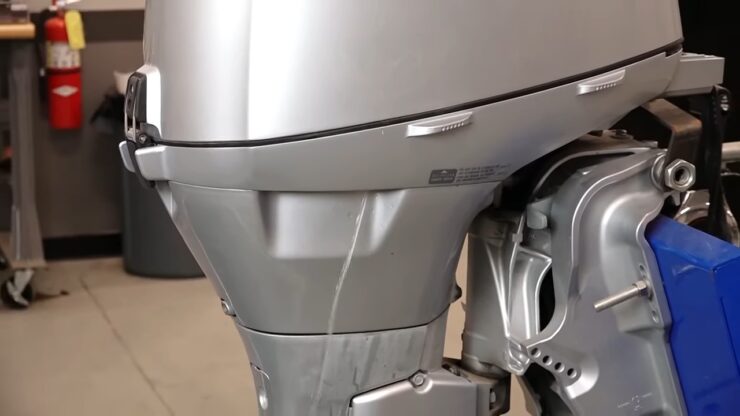
Use High-Quality Oil
Using high-quality oil can help prevent overheating by reducing friction in the engine. Make sure to use the recommended oil grade and change it regularly.
Avoid Running the Engine at High RPMs
Running the engine at high RPMs for extended periods can cause it to overheat. Avoid running the engine at full throttle for long periods of time, especially in hot weather conditions.
Check the Thermostat
If the engine is still overheating during the timing procedure, check the thermostat. Make sure it’s functioning correctly and opening at the right temperature. A faulty thermostat can cause the engine to overheat.
Check the Cooling System
If the water pump and thermostat are both working properly, check the cooling system. Make sure the cooling system is free of blockages and the water passages are clean. A clogged cooling system can cause poor water flow and lead to overheating.
Low-Input
Voltage regulation and ignition timing issues. You’ve probably already figured out that it reduces the engine’s power. The outboard motor operates slower with a heavier load.
An Inadequate Start
There may be an issue with the timing of the onboard engine. If you have difficulty starting it or hear knocking noises while trying to do so.
Using either too early or too late an ignition generates a number of issues. There’s also a shaky beginning.
Detailed Instructions for Evinrude Timing
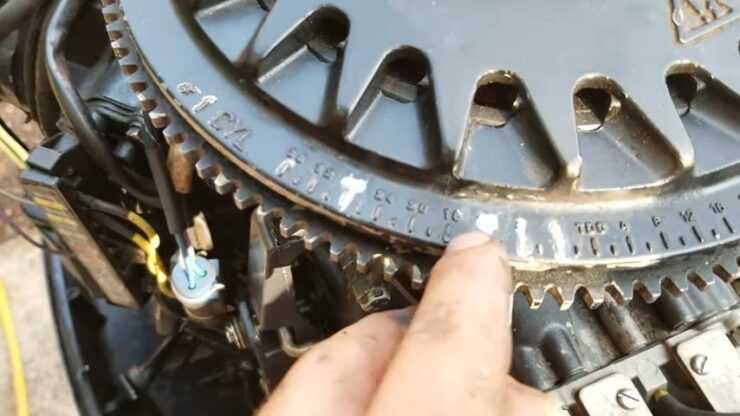
Are you positive that all three cylinders are receiving fuel? Motor won’t idle with one cylinder down. However, it can operate with the other two cylinders’ spark advance increased if necessary.
Let’s check the step-by-step procedure-
Step 1: Set the Spark Advance
Setting the spark advance to 16-18 BTDC is all you need to do in terms of timing. The idle time should be taken care of automatically. Motors are supposed to be running then.
The remaining plug wires should be grounded to prevent sparks from igniting the fuel. It may be spewed out of the plug holes.
Step 2: Set the Crankshaft
Set the crankshaft, then have someone turn the engine over for you. Spray some carb cleaning into each carb’s throat as you crank the engine. Check the johnson outboard shift linkage adjustment
It’s possible that only one of your carbs is supplying fuel. In this case you’ll need to replace it.
Step 3: Find the Spring
Remove the link rod from the plastic piece that connects to the roller of the fuel injector. Look up at the arms. On top of a piece of plastic, you’ll find a spring that causes the timer to spin.
Step 4: Move the Throttle
Let this spring cool down completely before moving on. When it comes to the rod on the carb, the rod ½ inch snaps back on.
But you need a 10 mm gap between the huge lump of plastic and the roller. These keep the timer from advancing.
When you move the engine, you’ll see that the throttle advances ahead of the timer. When you slide the throttle 1/4 inch, the timer starts.
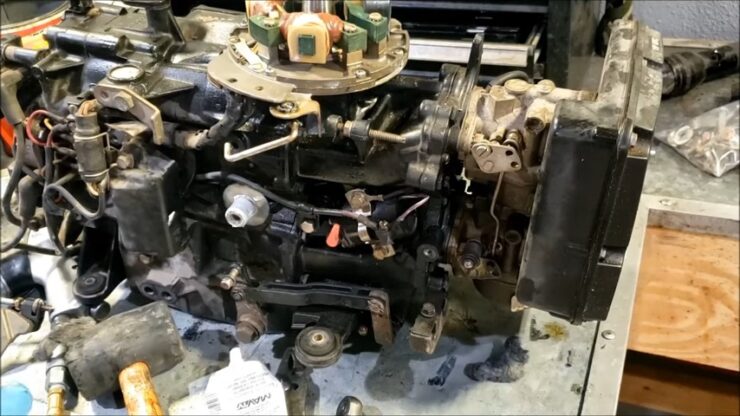
Step 5: Set the Timer
Set the timing to maximum advance now. Make sure the timer is pulled as far back as it will go. As this is where you want to see 18 btdc.
No need to worry about idle time. Since that will be taken care of by the system itself.
Step 6: Mark the Flywheel
Once the fuel supply has been disconnected, write 18/19 on the flywheel with a marker. Then connect a timing light, and set the throttle to full.
Turn the key to engage the bolt beneath the flywheel. Secure it once you’re done.
Step 7: Warm up the Engine
Now that you’ve gotten the timing somewhat perfect. It’s time to hook up the fuel and fire up the beast.
It’s best if you can get the boat in the water and under some kind of load. Let the engine warm-up for a few minutes now, even if it’s running at a high speed. You may want to adjust the slow speed on the outboard.
Once the engine is warmed up, check the timing again. but this time make sure the boat is tethered or you can do it while driving.
Avoid running the engine solely on carb cleaner due to the lack of lubrication. Only use it for testing.
FAQs
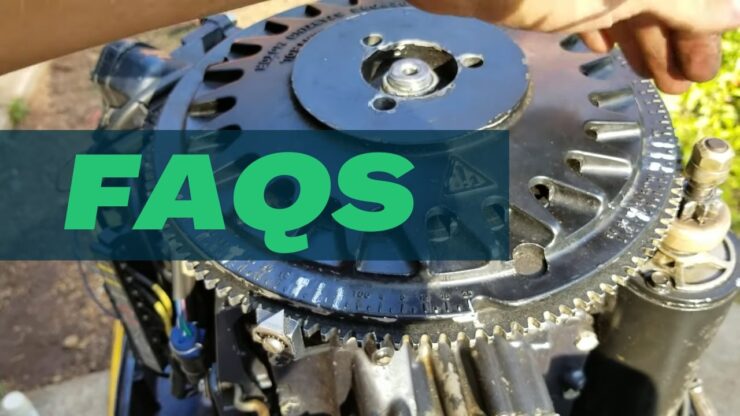
How do outboard motor points work?
Two-point contacts transmit a magneto spark to the ignition points on a Johnson outboard engine. It’s just like any other ignition point. The camshaft rotates to open and close the valves. This causes the point contacts to open and close.
How do I know if my ignition timing is correct?
To determine if your ignition timing is correct, you can use a timing light to measure the timing at idle. If the timing is too advanced or too retarded, the engine will run poorly and you may experience knocking or pinging.
You can check the engine’s vacuum advance to ensure it is functioning properly. If the advance is not functioning correctly, the timing may not be set correctly.
Finally, you can check the manufacturer’s specifications to ensure that the timing is set to the correct value for your engine.
For an outboard condenser, how do you do a test?
A condenser case (negative lead) and a wire termination should be touched by the metre leads (positive lead). The metre should deflect swiftly toward zero (discharge). Then slowly return to infinity when the battery recharges the condenser.
Is Repairing Outboard Timing Problems Expensive?
Take into account the boat mechanic’s hourly charge. Which is often between $70 and $10. As well as the cost of the parts that need to be replaced. In the case of a defective trigger, the service fee of an expert would only be about $250.
Why did they stop making Evinrude motors?
The decision to stop production of Evinrude motors was made by Bombardier Recreational Products (BRP) due to business reasons. BRP cited a shift in the recreational boating industry and a need to focus on more profitable products as the reasoning behind their decision. Additionally, BRP has an agreement with Mercury Marine to supply parts and service for existing Evinrude motors until 2028.
Are Johnson and Evinrude the same?
No, Johnson and Evinrude motors are not the same. While they were both produced by the Outboard Motor Corporation (OMC) until 1997, they have since become separate brands, with Evinrude engines focusing on two-stroke technology and Johnson engines focusing on traditional two-stroke engines.
Evinrude has since been acquired by Bombardier Recreational Products, which has shifted the focus of the company to more modern and efficient technologies.
Is Evinrude better than Yamaha?
Generally speaking, Evinrude and Yamaha outboard motors are considered to be of equal quality and reliability. However, some people may prefer one over the other based on their individual needs and preferences.
For example, Evinrude outboards are known for their superior torque, making them better suited for water sports and towing heavier loads. Evinrude outboards are able to generate more power at lower RPMs, which can be beneficial for those who need to travel at lower speeds.
On the other hand, Yamaha outboards are known for their fuel efficiency, making them a better choice for those who are trying to save money on fuel costs. Ultimately, both Evinrude and Yamaha outboards are high-quality and reliable motors, and the best option will depend on the individual needs of the user.
Conclusion
We are clear about your confusion about on evinrude timing procedure here. Your engine’s longevity will suffer if you don’t fix the timing fault, so please do it right now.
When combustion-related parts are damaged, the engine’s final failure results. Pay close attention to everything around you.
Take action if you even have the slightest inkling that something is amiss.
Go boating and have fun!
I’m Liam Jackson, the proud owner and driving force behind KayakPaddling.net. Born somewhere in the expansive beauty of the United States, I’ve nurtured a lifelong passion for kayaking and fishing that has led me to explore the far corners of our nation’s waterways.
Related Posts:
- Heavy Duty Fishing: 11 Best Rods And Reels For Big Fish 2025
- Johnson Outboard Rich Lean Adjustment - How is it Done
- 6 Symptoms of Bad Spark Plugs Outboard:…
- 10 Best Saltwater Fishing Boats - Ultimate Angling Adventure
- 10 Best Inflatable Kayak 2025 - Rivers, Lakes & Open Seas
- 12 Best Fishing Lures Ever 2025 - Baits That…

